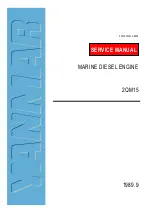
Manual for Induction Motors and Generators
40 -
Mechanical and Electrical Connections
3BFP 000 050 R0101 REV E
4.3.4 Main terminal box options
The inside of the main terminal box must be free from dirt, moisture and foreign debris. The box
itself, cable glands, and unused cable entrance holes must be closed in a dust- and watertight
manner.
The main terminal box is equipped with a drain plug at the lowest part of the box. The plug
should be in open position, i.e. half of the plug is inside and half of the plug is outside, during
transportation and storage. During operation of the machine, the plug should be kept in shut
position but opened from time to time. If the box is turned after delivery the drain plug function
must be checked, and possibly re-positioned at the lowest part of the box.
Some main terminal boxes can be turned in 90 degrees steps. Before turning, check that the
length of the cables between the stator winding and the terminal box is sufficient.
4.3.4.1 Delivery without main terminal box
If the machine is delivered without a main terminal box, the stator connection cables have to be
covered with earthed protective structure before commissioning. The structure must have the
same or higher enclosure classification and hazardous area certifications as the machine.
To avoid cable failure, stator connection cables must be shortened to minimize free movement
of the cables. The supplier of the terminal arrangement is responsible for ensuring that adequate
stator connection cable supports are used. The stator connection cable arrangement has to be
spacious in order to avoid overheating of the cables. Stator connection cables must not touch
sharp corners. The minimum bending radius of stator connection cable is 6 times the cable outer
diameter.
4.3.5 Insulation distances of main power connections
The connections of the main power cables must be designed to withstand demanding operation
conditions where the insulators can be subjected to dirt, humidity and surge voltages. In order to
ensure lasting and trouble-free running, it is therefore important that the length of the insulation
and creepage distances are sufficient. The minimum insulation and creepage distances should be
equal or exceed demands set by:
•
Local requirements
•
Standards
•
Classification rules
•
Hazardous area classification.
The insulation and creepage distances apply both for insulation distances between two different
phases, and for insulation distances between one phase and earth. The air insulation distance is
the shortest distance through air between two points with different electrical potential (voltage).
The surface creepage distance is the shortest distance along surfaces next to each other between
two points with different electrical potential (voltage).
4.3.6 Main power cables
The size of the input cables has to be adequate for the maximum load current and in accordance
with local standards. The cable terminals have to be of appropriate type and of correct size. The
connection to all devices has to be checked.
















































